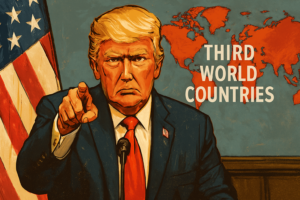Pete Hegseth’s Diplomatic Visit to the DMZ and the Future of U.S. Troops in South Korea

Overview of Pete Hegseth’s Visit to the DMZ
On a significant diplomatic mission, Defense Secretary Pete Hegseth traveled to the demilitarized zone (DMZ) between North and South Korea, underscoring the ongoing importance of this region in global geopolitical dynamics. The DMZ serves not only as a physical barrier but also as a symbol of the longstanding tensions in the Korean Peninsula, making visits by high-profile officials particularly impactful. Hegseth’s arrival at the DMZ was facilitated by a U.S. Army helicopter, which signified the military’s ongoing commitment to the area and its strategic importance.
Upon his arrival, Hegseth engaged in key discussions with South Korean Defense Minister Ahn Gyu-back. This meeting was pivotal in addressing pressing security issues and reaffirming the strong cooperation between the two nations. Hegseth’s presence at the DMZ highlighted the U.S. commitment to South Korea’s defense, particularly in light of North Korea’s evolving military posture. By reinforcing ties with South Korean leadership, he aimed to foster a unified approach to regional security challenges.
The broader context of this visit is crucial as it occurs against the backdrop of U.S.-South Korean relations, which have historically been marked by mutual support and military collaboration. Hegseth’s visit illustrated a renewed emphasis on bilateral cooperation as both nations navigate the complexities of North Korean provocations. By standing shoulder to shoulder with South Korean officials at such a significant location, Hegseth illustrated a united front in the defense of democracy and stability in the region. Ultimately, this visit not only showcased the ongoing partnership between the U.S. and South Korea but also set the stage for future dialogue on defense strategies and shared security interests.
The Role of U.S. Troops in South Korea
The presence of U.S. troops in South Korea has a long and complex history, dating back to the aftermath of the Korean War in the early 1950s. Originally deployed to assist in the defense of South Korea, U.S. military forces have played a crucial role in maintaining stability and deterring aggression from North Korea. Currently, around 28,500 U.S. servicemen and women are stationed in South Korea under the framework of the Mutual Defense Treaty, which reinforces the United States’ commitment to South Korean sovereignty and security.
The primary rationale for maintaining U.S. troops in South Korea is rooted in the ongoing security threats posed by North Korea. The regime’s continued development of nuclear weapons and missile technology presents significant challenges not only to South Korea but to regional peace and stability. The presence of U.S. forces acts as a critical deterrent against acts of aggression, illustrating the U.S.’s unwavering support for its ally. Moreover, by integrating with South Korean military forces through joint exercises and training operations, U.S. troops enhance the overall defense capabilities on the Korean Peninsula.
Implications of Reshaping U.S. Military Presence
The ongoing dialogue regarding the restructuring of U.S. military presence in South Korea encapsulates a multifaceted strategic endeavor that seeks to enhance regional stability while addressing evolving security challenges. As North Korea continues to develop its military capabilities, including advancements in missile technology and nuclear arms, the United States faces increased pressure to reassess its military posture in the region. Such adaptations are essential not only to deter potential threats but also to bolster the defense framework of both U.S. and South Korean forces.
One of the strategic objectives underpinning the potential restructuring is to ensure a more agile and responsive military presence that can effectively address both traditional and emerging threats in the Indo-Pacific region. This involves evaluating troop deployments, weapon systems, and support infrastructure. The U.S. aims to maintain a significant deterrent capability while also adapting to the rapidly changing geopolitical landscape, including relations with China and Russia, which may also influence regional security dynamics.
Domestic political considerations play a crucial role in shaping these military realignment discussions. In the United States, there is a growing debate about defense spending and global military commitments, leading some stakeholders to advocate for a re-evaluation of troop levels abroad. Meanwhile, in South Korea, public opinion and government policy can significantly impact U.S.-South Korea relations and dictate the terms of military collaboration. The bilateral alliance is foundational for both nations, and any changes to the U.S. military footprint could affect perceptions of reliability and commitment to joint security goals.
Furthermore, the implications of such a military realignment extend beyond the tactical level, influencing diplomatic relations and economic ties. Close cooperation on defense and security issues strengthens the partnership, creating a foundation for collaborative efforts in addressing common challenges. Hence, the successful realignment of military forces must be executed with careful consideration of both nations’ strategic interests.
Future Prospects for U.S.-South Korea Defense Talks
The diplomatic visit of Pete Hegseth to the Korean Demilitarized Zone (DMZ) underscores the ongoing commitment between the United States and South Korea to address evolving security challenges on the Korean Peninsula. As tensions persist, the future of U.S.-South Korea defense talks will be crucial in shaping military strategy and the deployment of U.S. troops in the region. The discussions are expected to focus on enhancing military readiness and strengthening the alliance in response to North Korea’s aggressive posturing.
Key stakeholders, including military officials, government representatives, and analysts, anticipate a series of intensive negotiations. The U.S. aims to reassure South Korea of its steadfast support, while South Korea seeks to balance national security interests with diplomatic avenues to mitigate escalation risks. Possible outcomes of these talks may include adjustments in troop deployments and an increase in collaborative exercises, thereby ensuring a robust defense posture against potential threats.
Moreover, the implications of these discussions extend beyond the immediate military framework. The stability of the region is contingent upon continued engagement and collaboration between the U.S. and South Korea. Analysts emphasize that the bilateral relationship is a linchpin not just for national security, but also for fostering mutual economic interests and cultural ties. As both nations navigate complex geopolitical landscapes, maintaining open lines of communication will be essential in addressing shared challenges.
In addition, further dialogue on defense capabilities, joint training programs, and the incorporation of advanced technologies may emerge as pivotal components of future negotiations. These efforts are aimed at not only deterring threats but also enhancing the overall security architecture in Northeast Asia. Hence, the U.S.-South Korea defense talks represent a critical avenue for solidifying strategic partnerships and ensuring lasting peace in a volatile region.







